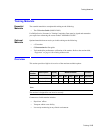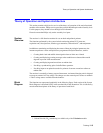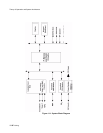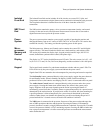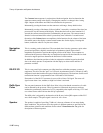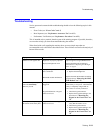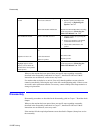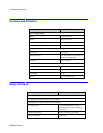Theory of Operation and System Architecture
11-10 Training
NBP
Processing
The NBP processing uses an oscillometric technique to provide needed measurements at
selected intervals. This technique uses an inflatable sphygmomanometer cuff similar to those
used by clinicians in routine measurements.
A motorized pump inflates the cuff to approximately 180 mmHg initially, at which point the
pressure effectively stops the flow of blood. Then, under monitor control, the pressure in the
cuff is gradually reduced, while a pressure transducer detects the air pressure and transmits
the parameter signal to the NBP input circuitry.
As the pressure is reduced, blood flows in the previously occluded artery, and changes the
measurements made by the transducer. The point at which oscillation increases sharply is
defined as systolic pressure. As the cuff continues to deflate, oscillation amplitude increases
to a maximum, and then decreases. The peak oscillation amplitude is defined as the mean
arterial pressure. The point at which the system detects a rapid decrease in oscillation is
defined as the diastolic pressure.
SpO
2
Processing
Measurement of oxygen saturation in the blood uses a specrophotometry technique. It is based
on the facts that oxyhemoglobin and deoxyhemoglobin differ in their absorbtion of red and
infrared light, and that the volume of arterial blood in tissue changes during the pulse.
Using these facts, a pulse oximeter passes red and infrared light into an arteriolar bed and
measures changes in light absorption during the pulsatile cycle. The light sources are red and
infrared light emitting diodes (LEDs), while the detection is accomplished by a photo diode.
To identify the oxygen saturation of arterial hemoglobin, the monitor uses the pulsatile nature
of arterial flow. During systole, a new pulse of arterial blood enters the vacular bed, and both
blood volume and light absorption increase. During diastole, blood volume and light
absorption reach their lowest point. The measurement is based upon the difference between
maximum and minimum absorption, focusing on the pulsatile arterial blood.
In addition to the oximetry function, the input signals may be used to calculate heart rate.
CO
2
Processing
The Microstream CO
2
board consists of an 80C552 Controller, the memory system (Flash
ROM, RAM, PLA, etc.), the Flow system (FilterLine recognition system, Inlet, solenoid
valve), Measurement Cell (Exciter, IR Source, Detectors and Temp Sensor) and an analog
section with ADC.
The gas inlet allows the connection of Microstream FilterLines. The FilterLines are detected
by the Optical Code Recognition.
Temperature
Processing
Measurement of patient temperature is accomplished by processing the signal from a probe
containing a resistor whose impedance is temperature dependent. The class of such
components is called thermistor.
The C3 is designed to accept the signals from electrically isolated Series 400 probes
manufactured by Yellow Springs Incorporated. Interchangeable probes in this series may be
used for esophageal, rectal, skin or surface, or airway temperature measurement. Probes are
furnished with a standard 10-feet lead. Extension leads are available.
The signal from the probe is conditioned by the monitor’s input circuitry, processed, and used
to drive the numeric display.




